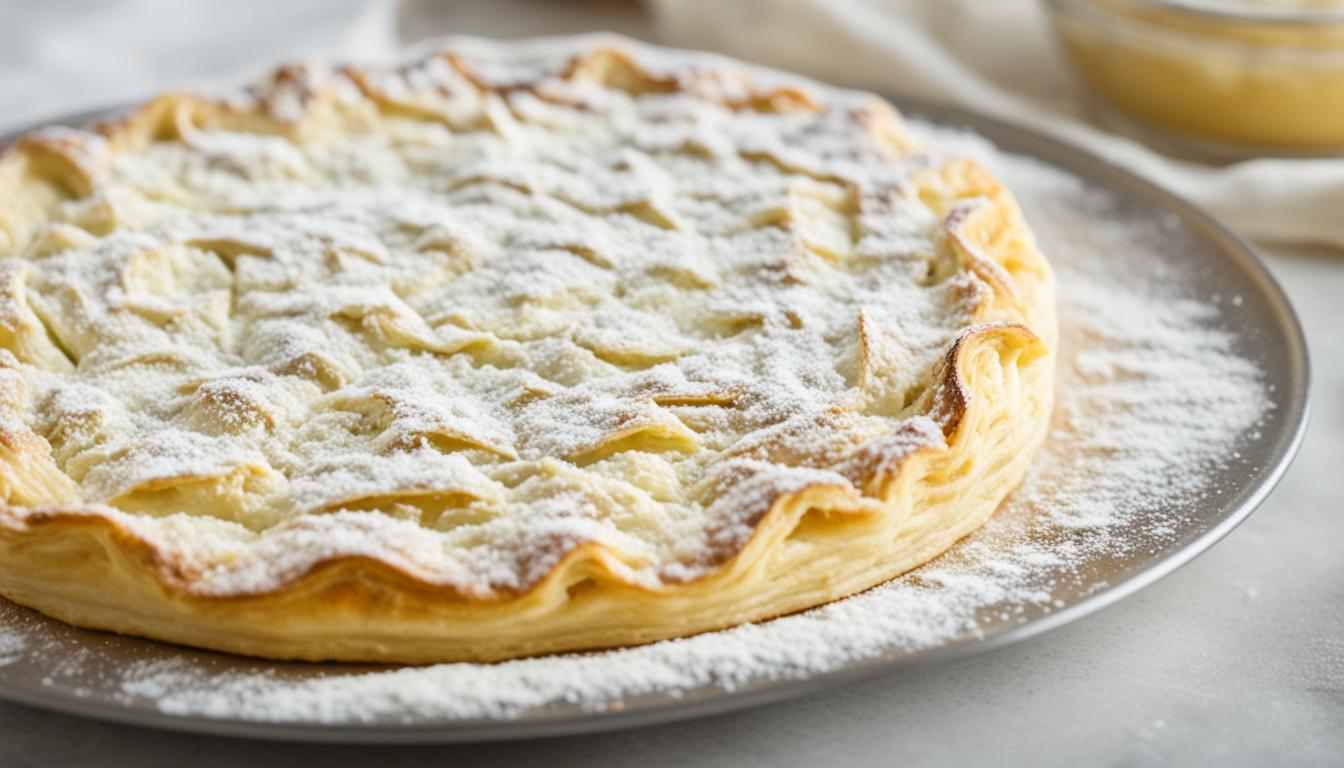Making flaky puff pastry at home has never been easier. With this quick and easy recipe, you can create delicious homemade puff pastry recipe that will leave everyone impressed. So put on your apron and get ready to embark on a buttery and flaky pastry adventure!
Forget about the store-bought puff pastry, because once you experience the light and crispy layers of this homemade delight, you’ll never go back. Best of all, this recipe uses simple ingredients that you probably already have in your pantry. Say goodbye to complicated techniques and hello to easy puff pastry perfection!
Our homemade puff pastry is perfect for both sweet and savory dishes. From pies and strudels to turnovers and vol-au-vents, the possibilities are endless. You can even use it in delicious desserts or as a flaky crust for your favorite quiches and tarts. Let your creativity run wild!
So, if you’re ready to elevate your baking game and indulge in the buttery heaven of homemade puff pastry, let’s dive into the recipe. Get ready to impress your friends and family with this quick and easy treat that will make your taste buds dance with joy!
Puff Pastry Recipe
Puff Pastry Ingredients
To make this homemade puff pastry, you will need the following ingredients:
- Butter at room temperature
- Plain/all-purpose flour (sieved)
- Salt
- Cold water
- Sugar (if making a sweet dish)
Puff Pastry Preparation
Once you have gathered all the ingredients, follow these steps to prepare the puff pastry:
1. Mix the sieved flour and salt together in a bowl.

2. Incorporate the butter into the flour mixture using your fingers or a pastry cutter until it resembles breadcrumbs.

3. Add cold water gradually and mix until the dough comes together. Be careful not to overmix.

4. Transfer the dough onto a lightly floured surface and knead it gently to form a smooth ball.

5. Roll out the dough into a rectangle shape.

6. Spread a layer of butter onto two-thirds of the dough, leaving one-third without butter.

7. Fold the unbuttered third over the center, then fold the remaining buttered third over the top.

8. Rotate the dough 90 degrees and repeat the folding process.

9. Repeat the folding and rotating steps for a total of 6 times.
10. Wrap the dough in plastic wrap and refrigerate for at least 30 minutes or until firm.

11. After chilling, remove the dough from the refrigerator and lightly flour your work surface again to prevent sticking.

12. Roll out the dough into a larger rectangle, about 1/4 inch thick. Make sure to keep the edges even and avoid pressing down too hard on the edges to maintain the layers.
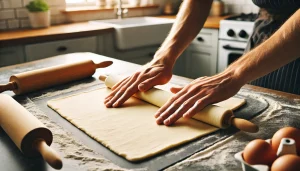
13. If you notice any cracks while rolling, gently press them together with your fingers. This ensures that the layers remain intact for better puffing during baking.

14. Once rolled out, you can use the dough immediately or re-wrap it in plastic wrap and return it to the refrigerator for later use. Puff pastry can be refrigerated for up to 2 days or frozen for up to a month.

15. When ready to use, preheat your oven to 400°F (200°C). If you’re making pastries, cut the rolled puff pastry into your desired shapes—squares, circles, or triangles.

16. For a shiny finish, brush the tops of your shaped pastries with an egg wash (a mixture of beaten egg and a splash of water or milk).
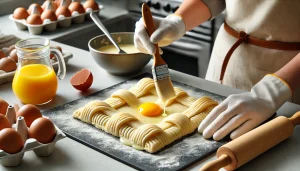
17. Place the pastries on a baking sheet lined with parchment paper, ensuring they are spaced apart to allow for rising.
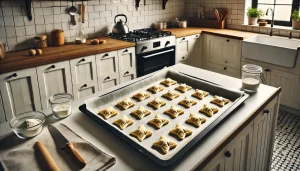
18. Bake them in the preheated oven for about 15-20 minutes, or until they are golden brown and puffed up beautifully.

19. Once baked, remove from the oven and let them cool on a wire rack for a few minutes before serving. Enjoy your delicious homemade puff pastry creations!
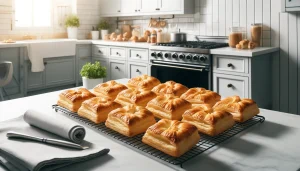
This versatile puff pastry can be used in a variety of recipes, including:
- Pies
- Strudels
- Turnovers
- Vol-au-vents
Puff Pastry Folding Technique
“The key to achieving flaky layers in puff pastry is the folding technique. By repeatedly folding and rolling the dough, you create thin layers of butter that separate during baking and create the characteristic flakiness.”
| Recipe Ideas with Puff Pastry | Ingredients |
|---|---|
| Honey Baklava | Phyllo dough, honey, nuts, cinnamon |
| Mini Cherry Hand Pies | Cherries, sugar, cornstarch, lemon juice |
| Ham and Cheese Roll-Ups | Ham, cheese, Dijon mustard |
| Pear, Walnut, and Chocolate Chip Crescents | Pears, walnuts, chocolate chips, sugar |
Tips for Success
Making puff pastry can be intimidating, but with these tips, you’ll be successful in creating a delicious homemade version. First, ensure that your working conditions are cool, as working with butter can be challenging in warm temperatures. It’s also crucial to preheat your oven to the correct temperature to achieve proper rising and flakiness.
Incorporating thin layers of fat between the dough is key to creating the flaky texture, so make sure to follow the folding and rolling instructions carefully. With these tips in mind, you’ll be on your way to making perfect homemade puff pastry.
“The key to a successful puff pastry lies in creating those delicate layers of flakiness. Ensure your working conditions are cool, preheat your oven properly, and be meticulous with the folding and rolling process.”
Here are some additional tips to keep in mind:
- Use cold butter: The butter should be cold but pliable. If it becomes too soft, it will melt into the dough, resulting in less flakiness.
- Work quickly: Puff pastry dough needs to stay cold to achieve the desired texture. Handle it as little as possible to prevent the butter from melting.
- Chill the dough: After each folding and rolling step, it’s important to chill the dough in the refrigerator to relax the gluten and firm up the butter.
- Be patient: Puff pastry takes time to make. Don’t rush the process and allow the dough to rest and chill between each fold.
- Use quality ingredients: The quality of the butter and flour will directly affect the flavor and texture of your puff pastry. Opt for high-quality, unsalted butter and fresh flour.
By following these tips, you’ll be able to create homemade puff pastry that is light, flaky, and absolutely delicious.
Avoiding Common Mistakes
While making puff pastry, it’s easy to make mistakes that can affect the final result. Here are a few common pitfalls to avoid:
- Overworking the dough: The less you handle the dough, the better. Overworking the dough can lead to tough and dense pastry instead of light and flaky layers.
- Using warm ingredients: Make sure all the ingredients, especially the butter and water, are cold. Warm ingredients can cause the butter to melt too quickly and compromise the texture.
- Skipping the chilling process: Properly chilling the dough at each stage is crucial for achieving the desired flakiness. Don’t rush and skip the chilling time.
- Rolling the dough too thin: While rolling out the dough, be cautious not to roll it too thin. Thin dough won’t have enough layers to create that ideal flaky texture.
Avoiding these common mistakes will help ensure that your homemade puff pastry turns out light, buttery, and perfectly flaky.
| Common Mistakes to Avoid | Tips for Success |
|---|---|
| Overworking the dough | Handle the dough as little as possible to prevent tough pastry |
| Using warm ingredients | Ensure all ingredients, especially the butter and water, are cold |
| Skipping the chilling process | Chill the dough at each stage to achieve proper flakiness |
| Rolling the dough too thin | Be cautious not to roll the dough too thin to maintain layers |

Famous Variations of Puff Pastry Recipe
Sainsbury’s Puff Pastry
Instructions:
- Prepare the Pastry: Roll out ready-made puff pastry on a lightly floured surface to the desired thickness.
- Cut and Shape: Cut the pastry into desired shapes or sizes using a sharp knife.
- Chill: Place the cut pastry in the refrigerator for about 10 minutes to firm up.
- Bake: Preheat the oven to 200°C (180°C fan) or 400°F. Brush the pastry with beaten egg for a golden finish. Bake for 15-20 minutes until puffed and golden brown.
- Serve: Use the baked puff pastry as a base or topping for your desired dish.
Difference: Sainsbury’s approach emphasizes using store-bought puff pastry for convenience, focusing on simple preparation and baking techniques.
Brie and Cranberry Puff Pastry
Instructions:
- Prepare the Pastry: Roll out puff pastry on a lightly floured surface to a rectangle of about 3-4mm thickness.
- Fill the Pastry: Cut the pastry into squares. Place a small piece of brie and a teaspoon of cranberry sauce in the center of each square.
- Seal and Shape: Fold the squares into triangles or any shape of your choice, sealing the edges with a fork.
- Chill: Place the filled pastries in the refrigerator for 10 minutes to firm up.
- Bake: Preheat the oven to 200°C (180°C fan) or 400°F. Brush with beaten egg and bake for 12-15 minutes until puffed and golden.
- Serve: Serve warm as an appetizer or snack.
Difference: This recipe combines puff pastry with a brie and cranberry filling, creating a sweet and savory appetizer with minimal effort.
Jamie Oliver Chicken and Leek Pie with Puff Pastry
Instructions:
- Prepare the Filling: Sauté 2 sliced leeks and 2 minced garlic cloves in butter until soft. Add 500g of diced chicken breast and cook until browned.
- Add Sauce Ingredients: Stir in 2 tablespoons of flour, then gradually add 300ml of chicken stock and 150ml of double cream. Simmer until thickened.
- Assemble the Pie: Transfer the filling to a pie dish. Roll out puff pastry to cover the top of the dish. Trim excess pastry and crimp the edges to seal.
- Chill: Place the pie in the refrigerator for 10 minutes to firm up the pastry.
- Bake: Preheat the oven to 200°C (180°C fan) or 400°F. Brush the pastry with beaten egg and bake for 25-30 minutes until the pastry is puffed and golden.
- Serve: Serve hot with a side of vegetables.
Difference: Jamie Oliver’s recipe focuses on using puff pastry as a lid for a rich chicken and leek filling, making it a hearty main dish.
M&S Puff Pastry
Instructions:
- Prepare the Pastry: Roll out ready-made puff pastry on a floured surface to the desired thickness.
- Cut and Shape: Cut into desired shapes or sizes, depending on your recipe needs.
- Chill: Chill the pastry in the refrigerator for about 10 minutes to ensure it stays firm.
- Bake: Preheat the oven to 200°C (180°C fan) or 400°F. Brush the pastry with beaten egg for a shiny finish and bake for 15-20 minutes until puffed and golden.
- Serve: Use as needed in various sweet or savory dishes.
Difference: M&S puff pastry is typically used as a versatile, ready-made option for various recipes, emphasizing convenience and quality.
Mary Berry Rough Puff Pastry Recipe
Instructions:
- Combine Ingredients: In a bowl, mix 225g of plain flour with a pinch of salt. Add 200g of cold, diced butter and mix briefly, keeping the butter in chunks.
- Add Water: Stir in about 100ml of cold water to bring the mixture together into a dough. Do not overmix.
- Roll and Fold: Roll the dough into a rectangle, then fold the top third down and the bottom third up, like folding a letter. Turn the dough 90 degrees and repeat the rolling and folding process 5 times, chilling for 15 minutes between folds.
- Chill: After the final fold, chill the dough for at least 30 minutes.
- Use as Needed: Roll out the chilled pastry to the desired thickness for your recipe.
Difference: Mary Berry’s rough puff pastry recipe is a simpler method that still achieves flaky layers, using chunks of butter and multiple folds with chilling in between.
Paul Hollywood Rough Puff Pastry
Instructions:
- Combine Ingredients: In a bowl, mix 250g of plain flour with a pinch of salt. Add 200g of cold, diced butter, keeping the butter pieces fairly large.
- Add Water: Stir in 150ml of cold water to bring the mixture together into a rough dough. Do not overwork.
- Roll and Fold: Roll the dough into a long rectangle, fold the top third down and the bottom third up, then turn 90 degrees and repeat. Complete this rolling and folding process 6 times, chilling for 15 minutes between folds.
- Chill: After the final fold, chill the dough for at least 30 minutes.
- Use as Needed: Roll out the chilled pastry to the desired thickness for your recipe.
Difference: Paul Hollywood’s rough puff pastry emphasizes larger pieces of butter and an extra fold compared to Mary Berry’s, aiming for a slightly more defined flaky texture.
Sweet and Savory Puff Pastry Recipes
Now that you’ve mastered the art of making homemade puff pastry, it’s time to explore the delightful world of sweet and savory dishes you can create with it. From delectable desserts to mouthwatering appetizers, the versatility of puff pastry is truly remarkable. Here are a few recipe ideas to inspire your culinary adventures:
Sweet Puff Pastry Recipe
- Honey Baklava: Impress your guests with this classic Middle Eastern dessert. Layer flaky puff pastry with a nut and honey mixture, bake to golden perfection, and drizzle with a sweet syrup for an indulgent treat.
- Mini Cherry Hand Pies: Use any leftover puff pastry to create these adorable hand pies filled with juicy cherries. Perfect for a sweet snack or dessert, these little delights are sure to satisfy your cravings.
Savory Puff Pastry Recipe
- Ham and Cheese Roll-Ups: Roll up slices of ham and cheese in puff pastry, bake until golden and crispy, and enjoy these irresistible savory bites. They make for a great party appetizer or a quick snack.
- Pear, Walnut, and Chocolate Chip Crescents: Indulge in the perfect combination of flavors with these savory crescents. Fill puff pastry with sliced pears, walnuts, and chocolate chips, then bake until golden and enjoy a delightful blend of sweet and nutty goodness.
The possibilities with puff pastry are endless, and you can customize the fillings and flavors to suit your taste. Let your imagination run wild and experiment with different ingredients to create your own unique puff pastry creations. Enjoy the process of crafting these delicious recipes and savor the buttery flakiness of homemade puff pastry.
Storage and Serving Suggestions
When it comes to homemade puff pastry, knowing the best way to store and serve it can make all the difference. By following these tips, you can keep your gluten-free pastry puff recipe fresh and enjoy the buttery puff pastry for days to come.
Storage Recommendations
If you have made a batch of homemade puff pastry and have some leftovers, it’s important to store them properly to maintain their freshness. Here’s what you need to do:
- Wrap the puff pastry tightly in plastic wrap to prevent it from drying out. This will help retain its moisture and prevent it from becoming stale.
- Place the wrapped pastry in an airtight container or a resealable bag to provide an additional layer of protection against air exposure.
- Store the puff pastry in the refrigerator for several days. The cool temperature will slow down the process of spoilage and keep it fresh.
By following these storage steps, you can enjoy your homemade puff pastry whenever you desire. It will maintain its flavor and texture, ready to be used in a variety of delicious recipes.
Freezing Tips
What if you have more puff pastry than you can consume within a few days? Freezing it is a great option to extend its shelf life. Here’s how to freeze your homemade puff pastry:
- Wrap the puff pastry tightly in plastic wrap, just as you would for refrigeration.
- Place the wrapped pastry in a freezer-safe bag or container to protect it from freezer burn.
- Label the bag or container with the date of freezing to track its freshness.
- Store the puff pastry in the freezer for up to a month. Be sure not to leave it in the freezer for too long as it may lose its quality over time.
When you’re ready to use the frozen puff pastry, follow these thawing steps:
- Transfer the frozen pastry from the freezer to the refrigerator.
- Allow the pastry to thaw in the fridge overnight. Thawing at a slow pace will ensure that the dough remains intact and doesn’t become soggy.
- Once thawed, you can roll out the puff pastry without unfolding it first.
With these freezing tips, you can always have homemade puff pastry on hand whenever you need it. It’s a convenient way to enjoy the buttery pastry without the need for constant preparation.
Serving Suggestions
Now that you have your homemade puff pastry ready, it’s time to serve it in delicious and creative ways. Whether you’re making sweet or savory treats, the options are endless. Here are some serving suggestions to inspire you:
- Create flaky fruit turnovers with a variety of fillings, such as apple and cinnamon, strawberry and cream cheese, or pear and almond.
- Make mouthwatering chicken pot pies by filling the puff pastry with a creamy chicken and vegetable mixture.
- Bake mini palmiers by sprinkling the puff pastry with sugar and folding it into a butterfly shape. The result is a sweet and crispy treat.
Remember to adjust the baking time and temperature based on the size and thickness of the pastry. This will ensure that your puff pastry bakes evenly and achieves the desired golden brown color.
So go ahead and explore the possibilities with your homemade puff pastry. Its buttery and flaky texture will elevate your recipes to a new level of deliciousness!

Conclusion
Making your own puff pastry at home may seem daunting, but with this quick and easy recipe, you’ll be able to create flaky and buttery pastry that is sure to impress. By following the simple instructions and tips provided, you can achieve light and crispy layers that rival store-bought pastry. Whether you use it in sweet desserts or savory dishes, homemade puff pastry adds a touch of elegance and deliciousness to your creations. So why not give it a try and enjoy the satisfaction of making your own puff pastry from scratch?
FAQ
Is making puff pastry from scratch difficult?
Making flaky puff pastry from scratch is easier than you think. With this quick and easy recipe, you can create delicious, homemade puff pastry that will impress your family and friends.
What are the main ingredients needed to make puff pastry?
To make homemade puff pastry, you will need butter at room temperature, plain/all-purpose flour (sieved), salt, cold water, and sugar (if making a sweet dish).
How do I make puff pastry from scratch?
The process involves mixing the sieved flour and salt, incorporating the butter and flour with cold water, rolling out the dough, layering it with butter, and folding it multiple times to create flaky layers. The dough is then chilled before it is ready to be used.
Are there any tips for making successful homemade puff pastry?
Yes! Ensure that your working conditions are cool, preheat your oven to the correct temperature, and follow the folding and rolling instructions carefully to create flaky layers.
What can I make with homemade puff pastry?
Once you have mastered making puff pastry, you can use it to create a variety of sweet and savory dishes, such as pies, turnovers, and vol-au-vents. Get creative with fillings to customize your puff pastry creations.
How can I store homemade puff pastry?
Homemade puff pastry can be stored in the refrigerator for several days. It’s best to wrap it tightly in plastic wrap to prevent it from drying out. You can also freeze it for up to a month.
How should I thaw frozen puff pastry?
To use frozen puff pastry, thaw it in the fridge overnight and roll it out without unfolding it first.
What is the recommended baking temperature for dishes made with puff pastry?
When serving dishes made with puff pastry, ensure that you bake them at the recommended temperature and adjust the cooking time based on the size of the pastry.
Is making puff pastry worth the effort?
Absolutely! Making your own puff pastry at home may seem daunting, but with this quick and easy recipe, you’ll be able to create flaky and buttery pastry that is sure to impress.
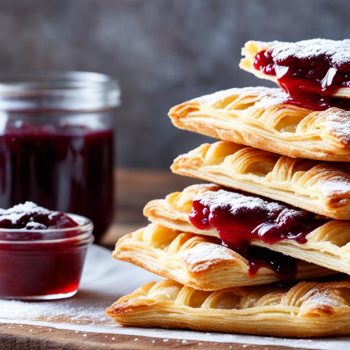
Puff Pastry Recipe
Ingredients
- Butter at room temperature
- Plain/all-purpose flour sieved
- Salt
- Cold water
- Sugar if making a sweet dish
- Puff Pastry Preparation
Instructions
- Mix the sieved flour and salt together in a bowl.
- Incorporate the butter into the flour mixture using your fingers or a pastry cutter until it resembles breadcrumbs.
- Add cold water gradually and mix until the dough comes together. Be careful not to overmix.
- Transfer the dough onto a lightly floured surface and knead it gently to form a smooth ball.
- Roll out the dough into a rectangle shape.
- Spread a layer of butter onto two-thirds of the dough, leaving one-third without butter.
- Fold the unbuttered third over the center, then fold the remaining buttered third over the top.
- Rotate the dough 90 degrees and repeat the folding process.
- Repeat the folding and rotating steps for a total of 6 times.
- Wrap the dough in plastic wrap and refrigerate for at least 30 minutes or until firm.
- After chilling, remove the dough from the refrigerator and lightly flour your work surface again to prevent sticking.
- Roll out the dough into a larger rectangle, about 1/4 inch thick. Make sure to keep the edges even and avoid pressing down too hard on the edges to maintain the layers.
- If you notice any cracks while rolling, gently press them together with your fingers. This ensures that the layers remain intact for better puffing during baking.
- Once rolled out, you can use the dough immediately or re-wrap it in plastic wrap and return it to the refrigerator for later use. Puff pastry can be refrigerated for up to 2 days or frozen for up to a month.
- When ready to use, preheat your oven to 400°F (200°C). If you're making pastries, cut the rolled puff pastry into your desired shapes—squares, circles, or triangles.
- For a shiny finish, brush the tops of your shaped pastries with an egg wash (a mixture of beaten egg and a splash of water or milk).
- Place the pastries on a baking sheet lined with parchment paper, ensuring they are spaced apart to allow for rising.
- Bake them in the preheated oven for about 15-20 minutes, or until they are golden brown and puffed up beautifully.
- Once baked, remove from the oven and let them cool on a wire rack for a few minutes before serving. Enjoy your delicious homemade puff pastry creations!


